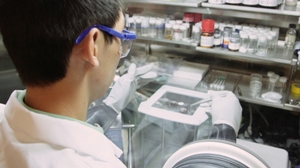Jul 18 2014
Tucked in a small laboratory at the Department of Energy's SLAC National Accelerator Laboratory, a team of scientists from the Stanford Institute for Materials and Energy Sciences (SIMES) is making and testing new types of lithium-ion batteries. Their goal: create a battery five times better than the ones we use today.
 Zhi Wei Seh assembles a prototype battery in SLAC’s energy storage laboratory. View the video embedded in this story to learn more. (SLAC National Accelerator Laboratory)
Zhi Wei Seh assembles a prototype battery in SLAC’s energy storage laboratory. View the video embedded in this story to learn more. (SLAC National Accelerator Laboratory)
Lithium-ion batteries work by moving lithium ions back and forth between two electrodes, called the cathode and anode (familiar to most as the "+" and "-" sides of a battery). Charging forces the ions into the anode, storing up energy to power a wide range of devices. Discharging moves the ions back to the cathode. The maximum amount of lithium absorbed by the electrodes determines a battery’s storage capacity.
The lab at SLAC is headed by Yi Cui, an associate professor at Stanford’s School of Engineering and at SLAC, with support from the U.S. Department of Energy's Joint Center for Energy Storage Research (JCESR). Cui believes one key to creating a better battery is making the cathode of sulfur, instead of today’s lithium-cobalt oxide.
Scientists have long known that sulfur can store ten times more lithium than lithium-cobalt oxide and that it’s also much cheaper. But unfortunately, sulfur presents its own challenges. For instance, when lithium ions enter a sulfur cathode during discharging, they bond with sulfur atoms to create a compound that's important for the cathode’s performance. But a portion of this compound then dissolves in the electrolyte, limiting the cathode’s energy capacity. After just a few charge/discharge cycles, these unwanted reactions greatly degrade the battery.
To solve this problem, the SLAC/Stanford research team devised a clever solution, called a yolk-shell design. Individual nano-nuggets of sulfur, each one-hundredth the diameter of a human hair, are enclosed within a semi-porous shell that allows lithium ions to pass through but blocks the electrolyte. Making the shell somewhat larger than the nanoparticle allows the sulfur to swell and contract as it absorbs and releases lithium during charge/discharge cycles without dissolving.
The research being done at SLAC aims to optimize the process for making yolk-shell structures and to match the sulfur cathode with a silicon anode, being developed in a companion SIMES laboratory on the Stanford campus, that can store much more energy than today’s anodes. The team's prototypes have already set records for these types of batteries, but need more research before they'll be ready for the commercial market.
Nonetheless, sulfur cathode results have been very promising and many teams around the world are now testing them. If their success continues, it may be only a few years before these experiments take energy storage beyond today's lithium-ion to the next generation of batteries.
Source: https://www6.slac.stanford.edu/